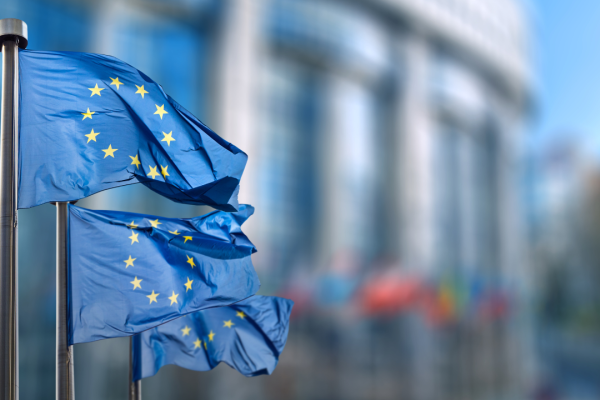
Vugge til Vugge Awarded Børsen Gazelle — Two Ye…
Vugge til Vugge has been honored by Denmark's leading financial publication with the Børsen Gazelle Award 2025, presented to the country's fastest-growing companies.
Read more →The Cradle to Cradle Congress 2025 at TU Berlin on 13-14 March was not just a conference—it was a showcase of how far we have come in the circular economy transition. Twenty years after the Cradle to Cradle framework was introduced in the groundbreaking book “Remaking the Way We Make Things” (by Michael Braungart and William McDonough), pioneers across industries are proving that circularity is not a distant goal but a current reality. Through groundbreaking product innovation, supply chain transparency, and business model shifts, they are demonstrating that circularity is not just a sustainability strategy, but a driver of competitive advantage, resilience, and long-term success.

The Entrance to the Cradle to Cradle Congress 2025, at TU Berlin
A defining theme of the congress was that companies are not waiting for policy—they are taking the lead. Bang & Olufsen’s Mads Kogsgaard Hansen, Head of Product Circularity & Portfolio Planning, exemplified this with the world premiere of their new modular soundbar, designed for easy disassembly, repair, and material recovery. This marks a radical departure from the traditional consumer electronics model, proving that circular design can be a competitive advantage. “We must design with the end in mind,” Hansen stated, emphasizing that electronics must be built for longevity and material recovered from the outset. With five products now Cradle to Cradle Certified® and more coming this year, Bang & Olufsen is demonstrating how high-end electronics can align with circular principles.
In fashion, roccamore’s Signe Marie Bakka Backhaus, Head of Design & Production, emphasized how durability, traceability, and transparency are redefining the industry. “Circularity is not just about making products better, but about challenging the very way we produce and consume,” she shared. By investing in materials that are fully traceable and designing products for longevity, brands are proving that circularity is both scalable and commercially viable.

Cradle to Cradle Congress 2025 - Session "Unlock circular design solutions", with (right to left) Mads Kogsgaard Hansen of Bang & Olufsen, Signe Marie Bakka Backhaus of roccamore, and Nienke Steen of C2CPII
Across industries, companies are leveraging data-driven transparency to scale circularity. From digital product passports in fashion to traceable raw materials in electronics and construction, businesses are investing in supplier engagement, lifecycle tracking, and disclosure frameworks.
Apple’s Frank Lenderink, Director of International Environmental Initiatives, shared insights into the company’s roadmap to 2030, highlighting that achieving full material disclosure remains a challenge but is essential for true circularity. “We are pushing for complete material transparency to ensure every component can be recovered and repurposed,” he explained. Circular pioneers are proving that deep supply chain integration is essential to making consumer electronics fully circular.
While policy frameworks like Germany’s National Circular Economy Strategy (NKWS) and the EU’s Extended Producer Responsibility (EPR) and Digital Product Passports (DPPs) are accelerating change, the real momentum is coming from businesses.
As Dr. Christiane Rohleder, State Secretary at Germany’s Federal Ministry for the Environment, pointed out, sustainability is shifting from voluntary commitments to mandatory requirements. Companies that embrace circularity before regulations demand it are positioning themselves as market leaders, not followers.
Cradle to Cradle co-founder Prof. Dr. Michael Braungart reminded us that the shift is not just about compliance but about rethinking the way we make things entirely. “There is no waste in nature. Everything is a nutrient for something else. The same must apply to our economy,” he stated.
"There is no waste in nature. Everything is a nutrient for something else. The same must apply to our economy."
The congress reinforced that business models and material choices are deeply interconnected in the circular economy. Companies must rethink both what they produce and how they generate value.
Product-as-a-Service (PaaS) is gaining traction, with companies moving toward leasing, refurbishment, and second-life solutions instead of traditional sales.
Recycling and remanufacturing require ecosystem-wide cooperation to ensure materials retain value beyond a single product cycle.
Investment in circularity is rising, with financing models evolving to support long-term circular strategies. Ana-Cristina Grohnert, Founding Partner at Score4Impact, who led a discussion on financing, highlighted that “we already have the tools to fund the circular economy at scale—we just need to align capital with impact.”
At the same time, the materials themselves matter more than ever. Elwyn Grainger-Jones, Executive Director of the Cradle to Cradle Products Innovation Institute, emphasized that circularity is only as strong as the materials we build it with. “Cradle to Cradle Certified® gives businesses the framework to ensure materials are safe, circular, and responsibly sourced—so they’re not just designing out waste but designing for long-term value,” he noted. The certification provides a science-backed foundation for companies to innovate with confidence and scale circular models that truly work.

Plenary session at the Cradle to Cradle Congress 2025
Transitioning to a circular economy is not just about supply chains and product innovation—it also requires engaging and educating consumers. Many speakers emphasized that transparency is only valuable if it translates into consumer trust and action.
During a panel discussion on circularity in culture and media, Johanna Jaurich, Director at fechnerMEDIA, highlighted the role of storytelling in shifting mindsets. “People don’t change behavior based on data alone. We need compelling narratives that make circularity tangible and desirable,” she noted.
Companies like roccamore are embracing this by embedding traceability directly into their customer experience, ensuring that buyers can see and understand the impact of their choices. The consensus was clear: brands that actively communicate their circular strategies will drive stronger consumer adoption and industry-wide change.
Scaling circularity is not about overnight transformation—it’s about enabling businesses to take structured steps while ensuring long-term impact. The Cradle to Cradle Certified® framework plays a key role in guiding companies through incremental improvements, setting clear milestones for materials, water stewardship, renewable energy, and social fairness.
As Dr. Eckart von Hirschhausen, Founder of Gesunde Erde - Gesunde Menschen, put it, “It is difficult to save the world on a voluntary basis when others are destroying it full-time.” The congress made it clear: scaling up circular solutions is the next frontier. Leading companies are embedding circularity across entire product portfolios, rather than treating it as a niche initiative.
Expert Prof. Ken Webster, Fellow at the Cambridge Institute for Sustainability Leadership, reinforced that circularity must go beyond material efficiency: “It’s not just about reducing harm—it’s about regenerative impact. We must create products and systems that restore, not just sustain.”
"It’s not just about reducing harm—it’s about regenerative impact. We must create products and systems that restore, not just sustain."
The 9th Cradle to Cradle Congress showed that circularity is no longer just a concept—it is the new business reality. Companies that take bold action today are defining the markets of tomorrow.
At Vugge til Vugge, we continue to support businesses in their Cradle to Cradle certification journey, ensuring that circularity is not just an ambition but an operational standard. The pioneers leading this movement are proving that circularity is a strategic advantage, a driver of innovation, and the foundation of future markets. The transition is already underway—it’s time to scale it up.

Vugge til Vugge has been honored by Denmark's leading financial publication with the Børsen Gazelle Award 2025, presented to the country's fastest-growing companies.
Read more →
The EU Green Claims Directive raises the bar for environmental communication. Discover how C2C Certified® helps substantiate claims with confidence.
Read more →
furnipart, Danish global leader in furniture handles, uses Cradle to Cradle Certified® as a blueprint for ESG, Scope 3, and supply chain transparency.
Read more →